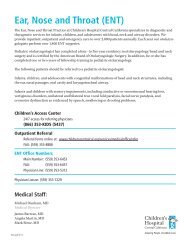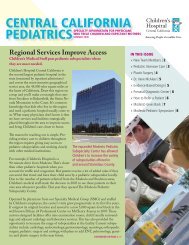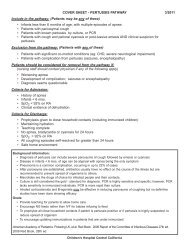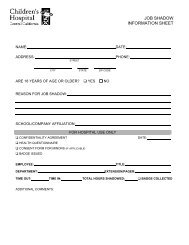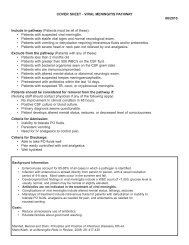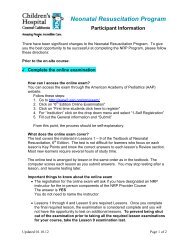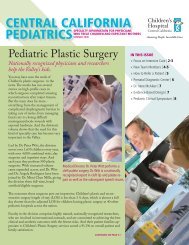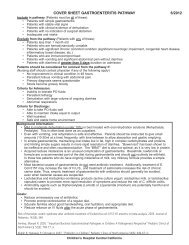Diabetic Ketoacidosis Pathway - Children's Hospital Central California
Diabetic Ketoacidosis Pathway - Children's Hospital Central California
Diabetic Ketoacidosis Pathway - Children's Hospital Central California
- No tags were found...
You also want an ePaper? Increase the reach of your titles
YUMPU automatically turns print PDFs into web optimized ePapers that Google loves.
4. Acidosis variable5. Anion Gap > 12 mmol/L ([Na+] - [HCO 3 - + Cl-]).a. Hyperchloremic metabolic acidosis can present with low bicarb and an anion gap < 12mmol/L.E. Fluids: goal is to avoid excessive fluid administration or rapid osmotic shifts. Be gentle. Donot over hydrate.1. General principles. Fluid therapy must be individualized. Good data are essential. Carefuland accurate I/O and daily weights are indispensable. Use a flow sheet to record vitalsigns, fluid, laboratory, and therapeutic data. Evaluate/reevaluate progress frequently andreadjust therapy as required.2. Patients should generally be kept NPO, especially if hyperventilating, vomiting, or havingan altered state of consciousness (ice chips may be appropriate).3. Initial fluids: begin hydration immediately, while waiting for labs. Normal saline is the bestinitial fluid for all patients. Initial therapy should be directed at treating hypovolemia IFPRESENT. In order to restore appropriate intravascular volume, give 10-20 ml/kg ofnormal saline as a rapid infusion. If necessary, can give additional 10 ml/kg every houruntil intravascular volume is restored.4. Initial rehydration can cause a significant drop in serum glucose. Need for hourly glucosemonitoring.F. Insulin: Remember that DKA is a state of insulin deficiency. Insulin therapy in DKA is aimed attreating not only hyperglycemia, but also ketosis and acidosis.1. A continuous IV infusion of regular insulin should be used in moderate-severe DKA.2. Begin piggyback solution of regular insulin 0.05-0.1 unit/kg/hr: CHCC standard insulininfusion solution is 1 unit/ml in normal saline. Insulin drip should be initiated at 0.05 /kg/hr if:a. Patient has serum blood sugar >1,000 mg/dl.b. Patient < 2 years old.c. DKA is less severe or serum glucose is < 500 mg/dl.3. The infusion rate should be increased if blood glucose does not fall at least 50 mg/dl perhour, or the bicarbonate does not rise at least 0.5 mEq/L per hour.4. The infusion rate may be adjusted up or down, but should not be discontinued until you areready to switch to subcutaneous therapy.5. Rate of fall in glucose should be 100 mg/dl per hour after initial drop associated withrehydration. There can, however, be significant interpatient variability (up to 400-500 mg/dlper hour drop). Therefore, monitor glucose frequently and adjust rate as needed.6. Practical aspects of insulin infusion therapy:a. Insulin loss on polyvinylchloride and glass can be significant. Never use aconcentration less than 0.1 unit/ml. Flush new IV tubing with 50 ml of insulin dripsolution prior to connecting to patient and starting insulin infusion.b. Make up fresh insulin solution at least every 24 hours.c. Because of adsorption, the actual amount of insulin being administered could besubstantially less than the apparent (labeled) amount. Adjustment of the insulininfusion rate should be based on effect and not solely on the apparent insulin dose.II. Ongoing ManagementA. Monitoring:1. Cardiac monitor should be used until metabolic status has normalized.2. It is often necessary to treat moderate-severe DKA in the PICU because of the need forfrequent blood draws, close monitoring of mental status, and 1:1 nursing (at least until thepH is > 7.25 and the serum bicarbonate is rising).3. A heparin lock is a humane method for obtaining repeat blood samples.page 2 of 5



